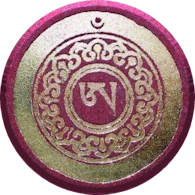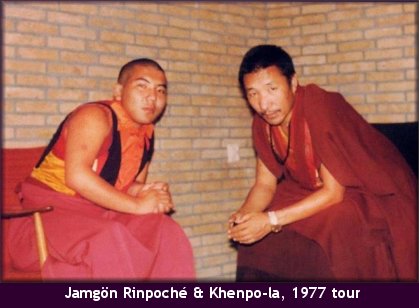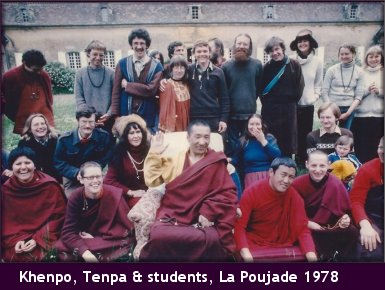
The Special Connection
with the XVIth Gyalwang Karmapa: 7
Rinpoché's Role in the 1977 visit to Europe of the Gyalwang Karmapa:
Part Four ... Founding the first Samye Dzongs and launching Khenpo Tsultrim
Samye Dzongs
Carlo Luyckx and Brigitte Cornelis were already Akong Rinpoché’s disciples at the time of the tour and they had been part of the group of people organising the Karmapa’s first passage through Belgium and the events in Antwerp and Brussels. Rinpoché gave them the task of finding and preparing a Brussels centre by the time of His Holiness’s return, later on in the year. Armed with little else but great faith, they managed the seemingly impossible and established the first satellite centre of Samye Ling, not known yet as a Samye Dzong but named by the Karmapa as Karma Shedrup Darjay Ling, in Rue Capouillet in the St Gilles district. It remains one of the major centres to this day and has received many very eminent masters. Likewise, the tour saw the birth of the Barcelona centre Karma Shedrup Gyamtso Ling.
The Karmapa did not visit Spain but received a group of Akong Rinpoché’s students from Barcelona, including the then Lourdes Clapès (now Lama Tsondru), and this gave rise to the Barcelona Samye Dzong in the same year.
The Birth of the “Africa” Connection
"Mummy" Sister Palmo had already visited South Africa and was probably the first Kagyu sangha to have gone there. During his stays in Samye Ling, the XVIth Gyalwang Karmapa had received Geoffrey Hardacre seeking advice on furthering the buddhadharma in which he had become involved in southern Africa. A first response to this had been, following discussion with Akong Rinpoché, to allow Ole Nydahl to visit and help beginners there understand more about the basics of Tibetan Buddhism. As mentioned above, the Karmapa was already playfully calling Akong Rinpoché Africa lama but at the time the future implications of this were only known to the Karmapa himself.
A connection was already being formed indirectly with Zimbabwe and South Africa through the academic Rob Nairn who, following a training in Southern Buddhism, was now a student of Akong Rinpoché and was already, along with Louis van Loon, a founder and pioneer of Buddhism in Southern Africa. The unsatisfactory nature of Ole Nydahl’s behaviour in Africa, as the self-styled “representative of the Karmapa in Africa” led to the XVIth Karmapa appointing Akong Rinpoché as his official representative to that continent and instructing him to teach there.
The launch of Khenpo Tsultrim and of More Formal Dharma Studies
 During the 1977 tour, Katia and I gradually fell into a study rhythm with Khenpo Tsultrim Gyamtso, usually involving a daily class (which had to be learned by heart for the next day), based on working systematically through the Tibetan and dharma meanings of Gampopa’s Ornament of Precious Liberation. From time to time, other people sat in or joined in. The process worked
well, largely thanks to Khenpo-la’s teaching skills, so much so that, to her astonishment, the Gyalwang Karmapa asked Katia, whose Tibetan had improved by leaps and bounds, to interpret for him during the November visit to Belgium and the new Brussels centre. His regular interpreter, Achi, had excellent and very well-mannered English but, being a young Tibetan brought up in a Catholic school in India, had almost no dharma knowledge and was very lost when it came to the rare dharma talks His Holiness gave.
In obvious frustration the Karmapa stopped Achi at one point and called up Katia. He afterwards told her that she had a special karma for Tibetan language and translation work and should follow it up.
During the 1977 tour, Katia and I gradually fell into a study rhythm with Khenpo Tsultrim Gyamtso, usually involving a daily class (which had to be learned by heart for the next day), based on working systematically through the Tibetan and dharma meanings of Gampopa’s Ornament of Precious Liberation. From time to time, other people sat in or joined in. The process worked
well, largely thanks to Khenpo-la’s teaching skills, so much so that, to her astonishment, the Gyalwang Karmapa asked Katia, whose Tibetan had improved by leaps and bounds, to interpret for him during the November visit to Belgium and the new Brussels centre. His regular interpreter, Achi, had excellent and very well-mannered English but, being a young Tibetan brought up in a Catholic school in India, had almost no dharma knowledge and was very lost when it came to the rare dharma talks His Holiness gave.
In obvious frustration the Karmapa stopped Achi at one point and called up Katia. He afterwards told her that she had a special karma for Tibetan language and translation work and should follow it up.
In some three months of study with Khenpo-la, Katia had equalled or surpassed those people who had spent years with Tibetan in India. One reason that this is mentioned is due to the consequences of that daily study class. Towards the end of the tour, Akong Rinpoché suggested to the Karmapa that Khenpo Tsultrim should stay on in Europe, in the Dordogne, rather than return to Rumtek with him to resume his Shedra duties there. Ken and Katia could study intensively with him for another six months and, at the same time, interpret for him for a class formed out of the people who had “dropped in” on their daily studies during the tour—more than a dozen people who wanted to learn more. The Karmapa thought this a good idea and added that he would tell Acharya Tenpa Negi to come and assist. Tenpa-la was an Indian-born Tibetan who had excellent Tibetan, English, Hindi and Sanskrit. He was the first Tibetan the author had ever met who could quote Shakespeare.
 It was thus that the Dordogne gained its Khenpo, already having its great meditator (Lama Gendun) and it was thus that a six-month intensive course was launched in the Chateau de La Poujade. The outcome of the latter was the publication, by us, of two key Kagyu study texts as well as the initial training of those who were to become some of the West’s first translators and interpreters.
It also established Khenpo Tsultrim’s connection with the West and led to the opening up of his own unique spiritual activity. All thanks to to Rinpoché’s suggestion!
It was thus that the Dordogne gained its Khenpo, already having its great meditator (Lama Gendun) and it was thus that a six-month intensive course was launched in the Chateau de La Poujade. The outcome of the latter was the publication, by us, of two key Kagyu study texts as well as the initial training of those who were to become some of the West’s first translators and interpreters.
It also established Khenpo Tsultrim’s connection with the West and led to the opening up of his own unique spiritual activity. All thanks to to Rinpoché’s suggestion!
......continue to the next part of the story: A beautiful long-life prayer
